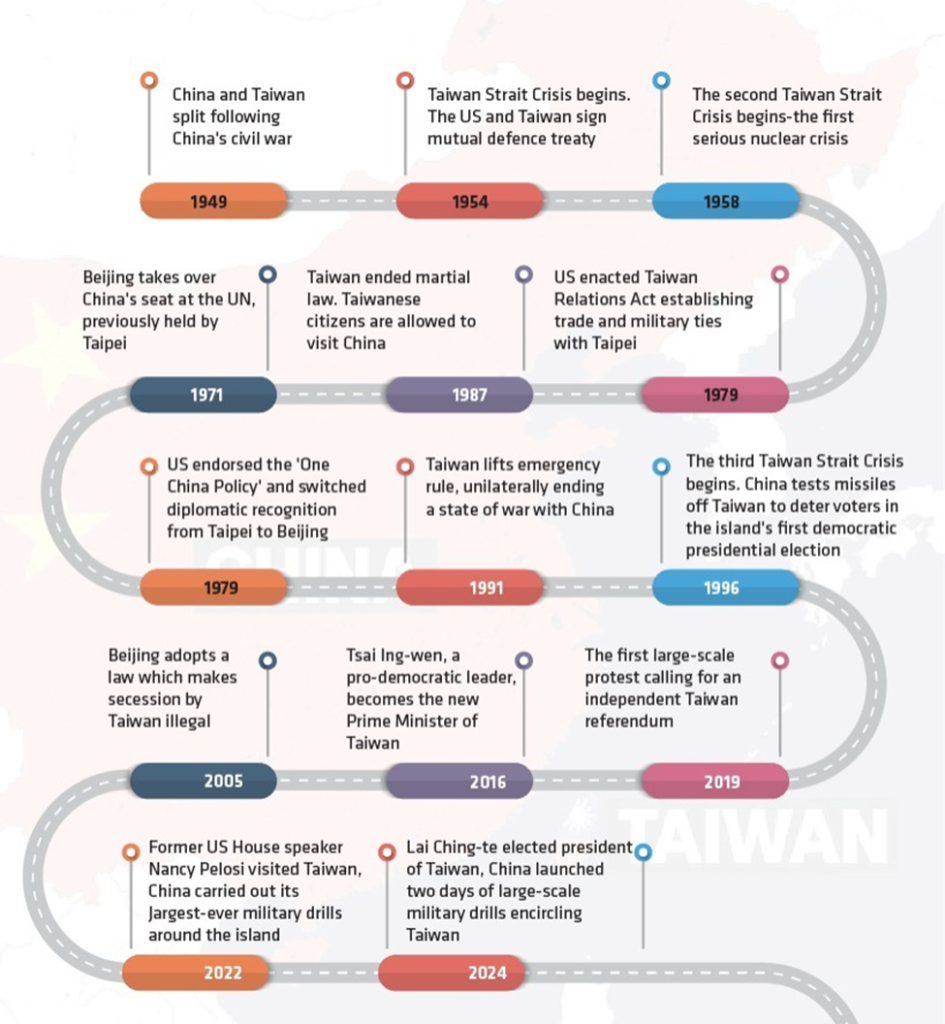US Defense Secretary Lloyd Austin and Chinese Defense Minister Dong Jun held their first face-to-face meeting in nearly two years at the Shangri-La Dialogue in Singapore.
You can also read: PM Hasina’s Beijing Visit: Boosting Bangladesh-China Trade
Despite this meeting, the fundamental issues surrounding Taiwan’s status and military activities in the South China Sea remain unresolved and contentious.
The Previous Taiwan Strait Crises

The Taiwan Strait, the narrow body of water separating mainland China from the island of Taiwan, has been the stage for several major crises involving the two nations over the past several decades.
The First Taiwan Strait Crisis, which took place from 1954 to 1955, saw the People’s Liberation Army (PLA) of China bombarding the Republic of China (ROC)-controlled islands of Quemoy, Matsu, and Dachen. In response to this aggressive action, the United States signed the Sino-American Mutual Defense Treaty with Taiwan.
In 1958, the Second Taiwan Strait Crisis erupted when China once again began shelling Quemoy and Matsu. The United States, staying true to its commitment, supported Taiwan by resupplying its garrisons on the besieged islands.
The Third Taiwan Strait Crisis occurred in 1995-96, coinciding with Taiwan’s first democratic presidential election. In an attempt to intimidate Taiwanese voters, China launched missiles near the island nation.
More recently, in 2022, tensions flared once again during the Fourth Taiwan Strait Crisis, triggered by US House Speaker Nancy Pelosi’s visit to Taiwan. China responded with its most extensive military drills to date in the waters surrounding Taiwan,
Likelihood of Invasion

IFlashpoints, when the invasion of Taiwan seems likely, NOTE: the Taiwanese Presidential Election flashpoint has already crossed without incident., source: Global Guardian
According to experts, the chances of China launching a full-scale invasion of Taiwan in the near future are relatively low, despite the heightened tensions between the two nations. This assessment is based on the significant military and logistical challenges that China would face in attempting such an operation.
The unique geography of the Taiwan Strait presents a formidable obstacle, requiring a complex coordination of air, land, and sea forces. Moreover, China’s current amphibious fleet is not considered sufficient to support a large-scale invasion, further limiting its options.

Instead of an outright invasion, analysts believe that a blockade or quarantine of Taiwan is a more likely scenario. This approach would allow China to exert pressure on Taiwan without the inherent risks associated with an amphibious assault.
The primary goal of such a strategy would be to deter Taiwan from seeking formal independence rather than forcing an immediate unification with the mainland. However, the same experts agree that a blockade will likely not achieve China’s goals.

Political considerations also play a significant role in shaping China’s actions. Under the leadership of President Xi Jinping, the Chinese government has emphasized the importance of peaceful reunification, even though it has not completely ruled out the use of force.
The Chinese leadership is acutely aware of the potential economic and military consequences that a direct invasion would entail. Furthermore, the United States’ policy of strategic ambiguity and its ongoing support for Taiwan adds another layer of complexity to China’s decision-making process.
Overall, while the situation across the Taiwan Strait remains tense, the immediate risk of a Chinese invasion appears to be low.
Easing Tensions Through Dialogue
At the Shangri-La Dialogue in Singapore, US Defense Secretary Lloyd Austin and Chinese Defense Minister Dong Jun held their first face-to-face meeting in 18 months, with the primary objective of restarting high-level military communications that had been suspended since 2022.
The discussions also encompassed regional security matters and reaffirmed the importance of maintaining freedom of navigation and stability in the region.
Analysis of the Meeting
The recent US-China defense chiefs’ meeting in Singapore marked a significant step in easing tensions between the two nations. Discussions focused on maintaining open communication to prevent misunderstandings and miscalculations, particularly in sensitive areas like the Taiwan Strait and South China Sea.
Both sides emphasized the crucial role of dialogue in stabilizing military relations, suggesting a shared interest in avoiding direct conflict. This mutual understanding is encouraging, demonstrating a willingness to work towards a more stable future.
However, the underlying issues contributing to current tensions remain largely unresolved, leaving the prospects for long-term de-escalation somewhat uncertain. Despite this, the overall constructive tone of the talks is a positive sign, indicating that both the United States and China recognize the importance of managing their complex relationship to maintain regional stability.
Will the US Come to Taiwan’s Aid?
The US has vowed to support Taiwan if China invades, with President Biden affirming the US defense of Taiwan, signaling strategic clarity but also ambiguity about the extent of intervention.
The Taiwan Relations Act obligates the US to provide defensive weapons to Taiwan, but direct military engagement remains uncertain.
Conclusion
The US-China defense chiefs’ meeting in Singapore was a crucial step in restarting military dialogue, acknowledging the need for better communication to avoid conflicts.
However, contentious issues like Taiwan and the South China Sea persist. While the dialogue may ease immediate tensions, it doesn’t resolve the fundamental strategic rivalry. The stability of US-China relations in the region will hinge on future interactions and their ability to manage these intricate challenges.


